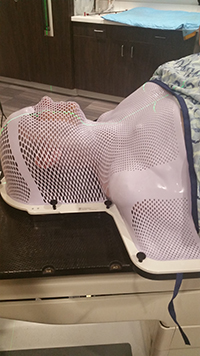Deciding on Radiation Treatments
"Your tumor is growing. I am sorry, but I am pulling you out of your clinical trial," my oncologist said. And, with that, my world came crashing down all around me.
I was in the trial for four years. I loved it. I felt comfortable in the trial. I didn't want to leave it. But, it wasn't my decision. And, honestly, it made no sense to remain in it if at least one tumor was no longer responding to the treatment.
Deciding on radiation
After much soul-searching and googling, I decided that my best course of action was to undergo radiation and I wanted to have SBRT (Stereotactic Body Radiation Therapy). What I knew about SBRT could fit into a thimble, but I did know that it was strong radiation delivered in just a few treatments. I liked the idea of just a few treatments. I didn't want to be inconvenienced by having to drive to my radiation center day after endless day. It takes me 45 minutes to an hour each way to drive to the clinic. Driving in Dallas isn't my favorite thing to do.
So, I met with a radiation oncologist to discuss this SBRT treatment I had chosen as my next course of treatment. I got a little education about radiation. I learned that SBRT was not the right treatment for me. The location of my tumor was not conducive to such strong radiation delivered in a short amount of time.
IMRT is the best fit for me
The good news is that I was a candidate for IMRT (Intensity-modulated radiation therapy). My radiation oncologist explained that this treatment uses advanced technology that manipulates photon and proton beams of radiation to conform to the shape of the tumor. The damage to surrounding tissue is minimalized. I would need to come to the clinic every weekday for 15 days. Each treatment would take only about 10 minutes.

Do I have to wear the mask?
Okay. That was doable, but I had heard about masks that some people had to wear while undergoing radiation. I told my doctor, "I will lay real still. I don't want a mask." He humored me and said he'd look at the tumor, its location, and consider not requiring a mask. However, he said the mask was a way to ensure that the radiation was hitting the tumor and not the healthy tissue around it. We not only wanted to kill the tumor with radiation, we wanted the beams to hit as little of the healthy tissue as possible.
For anyone who has had radiation, it will come as no surprise that I needed a mask. Big sigh. The treatment plan I had devised for myself (SBRT and no mask) had fallen completely apart! But, as a glass-half-full kind of person, I quickly latched onto the ideas that at least radiation was an option, the oncologist thought he could destroy the tumor, and I would only have to drive back and forth for treatments for 15 days. Not ideal, but certainly doable.
Looking at the bright side
The fifteen days passed far more quickly than I imagined they would. I learned quickly that I could breathe and see what was going on around me just fine with the mask in place.
I got to bring the mask home with me after I completed my treatments. Some people never want to see theirs again. But mine represents an obliterated tumor to me.

Join the conversation